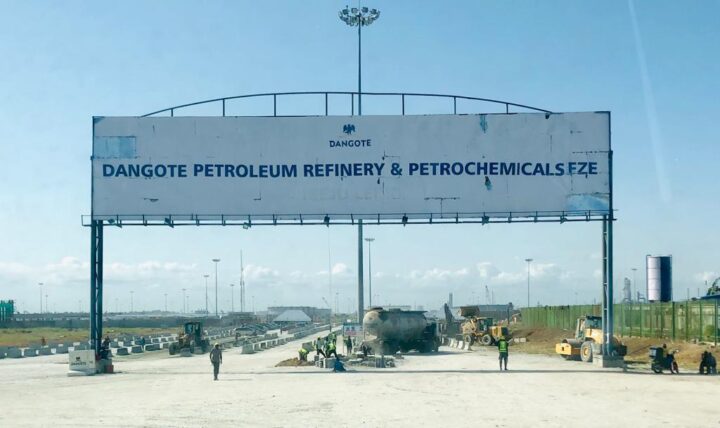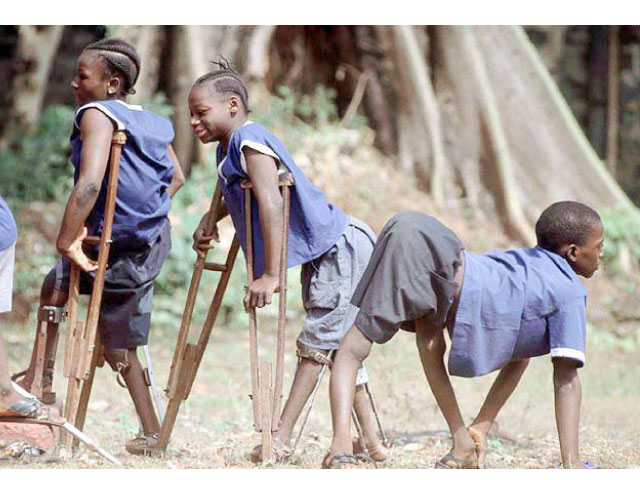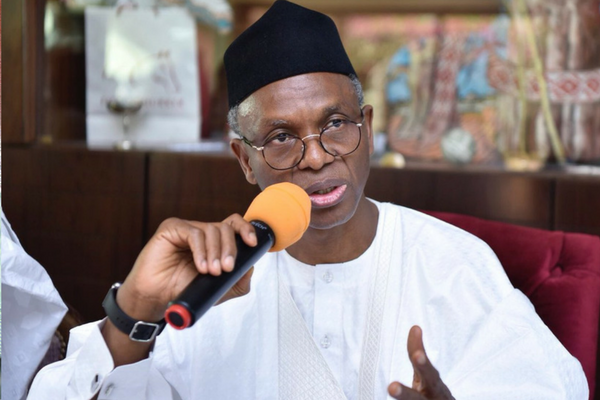Equatoria (Turning Tides)
| Capital | Port Libre |
| Largest city | Port Libre |
| Other cities | Kaluma, Bandari, Juba, Sainte-Marie |
| Language official | French |
| others | Runyakitara, Maraba, Arabic, Swahili, Kambiri |
| Area main | 394,196.04 km² |
| water (%) | 41.799% (164,773.14 km²) |
| Population | 12,845,921 |
| Independence | from France |
| declared | 1968 |
| Currency | Equatorian Franc |
| Organizations | UN, OPEC, Arab League, Francophonie, African Union, Azanian League |
Equatoria (Équatorie), officially the Republic of Equatoria (Republique de L'Équatorie), is a country in Azania. It borders Sheba to the north and east, and Kenya to the South and East again, it also has maritime borders with Kush, Congo, Katanga and Egypt to the west.
The first people in the area were the Hadza people. Originally, Hadza people only lived on the mainland but over time settled on the numerous islands of modern-day Equatoria. Bantu people first started to arrive in the 500s and 600s, although significant settlement only started around the year 1000.
Some of the Bantu people created a maritime empire in modern-day Equatoria, called the Empire of Kitara. The state formed under the Tembuzi dynasty, although the exact date of the nation's founding is unknown, but is known to have been before the Great Migration of 1000 AD. The Bantus of Kitara coalesced into the Kitara ethnic group.
Around a century later, Arab traders arrived, bringing modern-day Equatoria into their sphere of influence, culturally and financially. Yemeni Arabs, Shirazi Persians and West Indians all saw that islands off the coast had no real value, but they were seen as the edge of civilisation and the gateway to lucrative trade routes from the heart of Africa. Arab and Bantu culture merged in a creole known as Swahili. Native chiefs and noble merchants intermarried and became Sultans after converting to Islam. These new Islamic states, which had once been tribes under Kitara's influence, had now grown wealthy from trade with the Middle East and were enjoying the culture of the Islamic golden age. Kitara started to decline and many of their elites converted to Islam during this period, and a mixed Afro-Arab dynasty known as the Al Said Dynasty took power from the Chwezis.
Several islands in the south of the archipelago were still inhabited by hunter-gatherer Hadza people. When the Portuguese arrived on these Southern islands in 1502 the natives were wiped out by disease, and the Portuguese soon established colonies on these islands. The Portuguese named their new colony "Ilhas da Maré Vermelha", meaning Red Tides Islands. The Portuguese soon established a colony at Mombassa. They were impressed by the wealth of the coastal Islamic states, they used threats of military action to force many into submission. During this time, the Sheban military and private slave-traders, equipped with Portuguese muskets, began a series of invasions across Southern Azania, East Africa and the islands of the Eritrean sea. These attacks, which were actually massive slave raids that came to be known as the "Red Raids". Equatoria had an estimated population of 540,522 at the time and half of the population was either killed or adducted to be sold. Much of the Eritrean sea islands were depopulated and functioning society collapsed in the region. Intellectuals and those in leadership positions were killed since it was seen that if they were educated they would be more rebellious, a trait also given to anyone with military experience to justify their killing, leaving peasants, tribal people, women, children and the urban poor as those that were captured. Cities, especially coastal ones, were in ruins and were abandoned by their inhabitants since they had all been killed, captured or displaced. The ruined remains of cities were occasionally used as barracks or slave-ports. Rural areas saw a large number of people taken while the fields had either been burned or had the crops taken, similarly to how livestock was slaughtered and taken back to ships. The only semblance of functioning society was the cimarrón (loanword from American Spanish which arrived though the Portuguese) settlements, being groups of people who fled to the wilderness to form their own settlements and defenses. Life for cimarrón people was very difficult on its own and they faced frequent attacks from slave traders.
Due to the rapid depopulation their was little resistance to Portuguese and Sheban expansion.
The Portuguese colony that was created by this land grab was called Ilhas da Maré Vermelha. The Portuguese later used these islands as a staging ground for expansion onto the mainland, notably at Mombassa, which was acquired in 1552. The Ilhas da Maré Vermelha colony was used for very little beyond plantation agriculture. Mombassa quickly became Portugal's main port in the area and became the capital of the Portuguese possessions in the area. The region was briefly occupied by the Dutch.
Oman conquered the Portuguese lands at the Battle of fort Jesus in 1696 and they copied the Caribbean-style slave plantations. The Portuguese were expelled and Arab colonists from Oman and Yemen were brought in to begin settling the territory. A small minority of the new Arab arrivals were from the Omani nobility, they took control of the old Portuguese plantations while also expanding them across their newly acquired lands. The Arabs refered to these plantations as "shambas" (شامباس). The region then became one of the wealthiest parts of the Omani empire. There was often conflict with the cimarrón, who originally saw the Omanis as people who might help due to a shared Islamic faith, they came to hate them when they saw that the former Kitara territory was being used as land for plantations. They especially hated that some Kitara captured in the Red Raids were now enslaved by the Omanis. As such, society remained very decentralised, with vast Arab-owned plantation estates, scattered cimarrón villages and occasionally large urban areas such as Bandari and Kaluma. There was also a massive revolt in 1779 to 1784, although it was suppressed successfully by Omani forces with British assistance.
During this period the Omanis monopolised exports of African slaves to the Middle East. Around 8 million Africans ended up as slaves in the Islamic World, making Oman the nation that has traded the most slaves in history. In the Omani period most slaves were exported, while many remained in the colony itself, they were used as dock workers, pearl divers, irrigation canal workers, agricultural labour, mamluks and domestic servants. Some Caucasian slaves (Circassians and Georgians) and Balochis were brought to the region as slaves as well.
The Omani Empire gave control of their African/Azanian possessions to the Mazrui clan. Various Omani Clans were appointed by Muscat to rule overseas territories on their behalf.
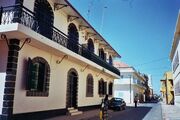
The Old Town of Sainte-Marie is the best example of French Colonial architecture in Equatoria
By the Mid-1600s, France had no colonies East of the Cape of Good Hope, and were limited to the Atlantic World. This was due to Portuguese Domination of the Indian Ocean and Eritrean Sea, which left France uneasy since Portugal was one of England's oldest allies. After Portuguese losses to the Dutch and later Oman (starting in 1660), France realised that the Portuguese were declining and that they had an opportunity to expand into what was once Portugal's sphere of influence. France started by sending ambassadors to Safavid Persia (who had previously been allied to England while being opposed to France due to its alliance with the Ottomans). In 1664 the Compagnie française des Indes orientales (French East India Company) was founded to capitalise on Portugal's decline. In 1665 a company ship landed on the Azanian Mainland located East of the Ilhas da Maré Vermelha, naming their new colony Rivière Sainte-Marie. The French exerted control by building forts and occupying coastal towns, then gradually expanding inland. This colony quickly began to grow cash crops, namely sugar and coffee, as well as grapes, grains, dates and pomegranates. The Omani conquest of the nearby Portuguese colonies was essential to the success of the Rivière Sainte-Marie colony, as both Oman and France believed that their colonies would fail if they did not trade with the other. Limited arable land on the islands (while most of that arable land was used for plantations) meant that the Omani colonies of the Eritrean Sea were dependent on grain imports from Rivière Sainte-Marie.
French Corsairs used Rivière Sainte-Marie as a base to launch attacks on enemy merchant ships in the Red and Eritrean Seas, especially English and Dutch ships coming from India. Goods such as silk, spices, jewels, silver and gold were frequently targets. Local merchants often fenced stolen goods. The presence of the Corsairs soon attracted non-licensed pirates of various nationalities, many of whom began to target Pilgrim Ships on their way to Mecca. From 1686 to 1688, the French Navy and local allies begin a campaign to eliminate the threat of piracy in the Eritrean Sea in a conflict that became known as the Corsair War.
During the 7 years war French Corsairs raided a British concession in Oman, destroying the settlement and capturing several ships, despite diplomatic protests by Oman through the French consul in Baghdad, this actually served to open direct diplomatic relations between France and Oman. The colony of Rivière Sainte-Marie was occupied by the British during the Seven Years War, but after the war was over there were disputes between the British and French over who would control it, as happened in many of France's colonies. In the end the colony was split in half, with Northern half being returned to French control while the South became the new colony of British Azania. In 1785 France requested a territorial concession on the island of Harashat from Oman. It was given in 1788, and eventually grew to become Port Libre.
French influence grew in Oman after 1792, when Sultan ibn Ahmed was brought to power with the help of French marines, resulting in several of Oman's Azanian colonies coming under French influence, especially as these colonies became more economically significant. The French revolutionary wars led to France ignoring their overseas colonies, while the French corsairs of Rivière Sainte-Marie once again became active in Omani waters, leading to an Omani blockade of French ports, leading the British to reject the need to occupy it since it was effectively blockaded by Oman, although some small-scale skirmishes took place between British and French militias along the border between British Azania and French Azania.
In 1835 a group of Muslim Bantu tribes united under an absolute monarchy known as the Sultanate of Juba. The new nation quickly formed an alliance with Oman. When Juba attempted to expand eastward into the Azanian interior in 1840, France intervened to prevent this. Juba signed a treaty where they recongnised France as their primary ally.
Around the same time, the use of palm oil to create soap and candles became more common than using tallow or whale oil, and the city of Sainte-Marie became a centre of palm oil production. At this time the colony was named Rivière Sainte-Marie and Dependencies, which included Sainte-Marie, Port Libre and several small islands (such as Tromelin Island).
At the Berlin Conference there were several European nations that attempted to claim the Omani colony of Ajan, including the French, British and Italians. At this time Oman itself was a British protectorate and numerous Omani colonies had been incorporated into British Azania, while France was well-established in the area as well. The Italians had ambitions to expand across all of Azania and tried to claim that the Romans had once been in modern-day Equatoria, which was proved false by archaeologists. Italian nationalists would later claim that the region had been “stolen” from them at the Berlin Conference and Mussolini briefly attempted to act on this sentiment. Portugal also briefly attempted to claim Ajan based on the fact that the Omanis had conquered the region from them, but this claim was ignored by the Great Powers of Europe in a similar way to how they had ignored most of Portugal’s other claims from the Pink Map.
In the end France purchased Ajan from Oman and united the new territorial acquisition with Rivière Sainte-Marie and Dependencies to create the new colony of French Azania (Azanie Francaise). By this point the colony was mostly urbanised, largely due to its island geography, with the exception of the remaining cimarrón tribes who still lived in small communities in the forest. The French government promised that any Omani citizen could return to Oman at the expense of the French government, this deal did not include any slaves. France abolished slavery and some Arab and Swahili slave owners revolted but the uprising was suppressed. Many of the newly freed slaves viewed France as a liberator and became staunch Francophiles. Catholic missionaries found that converting former slaves was very easy and a large portion converted to Catholicism.
Due to the Francophilia among the lower classes there was a large population that was willing to fight for France in times of war. Local troops fought in the French conquest of Chad, Morocco and Benin, while also helping to crush uprisings such as the Kongo Wara rebellion, Samori Toure's rebellion and the Volta-Bani War. Even by the 1960s they still fought in the First Indochina war and the Algerian war of independence on the side of France.
In 1890 the French navy intercepted a collection of illegal slave ships and tried to board it to arrest the traders on board. The ships found sanctuary in the Sultanate of Juba, whose shore guns fired on the French navy. In Response, France and Sheba led a joint punitive expedition against Juba that ended in its partition between the two states. This conflict allowed France to expand its colony on the Azanian mainland, a territory that is still a part of Equatoria today.
Majority of the slaveholding elites accepted the abolition of slavery without protest. Many of the former slave owners became colonial administrators and many adopted French dress and customs, but they still remained Muslim. Many sent their children to be educated in elite schools in France and Austria while many served as officers in the French military. Many of the cimarrón approved of French abolitionism but still fought them due to their historic resistance to outside colonisers. This lead to a major divide in cimarrón culture, going as far as pro-French cimarrón raiding anti-French cimarrón.
Infrastructure such as defenses, schools, hospitals and churches were built throughout the territory. Rural populations benefited immensely from this, leading to widespread pro-French sentiment among that demographic.

Oil field in Port Libre, 1900
French land surveyors soon discovered that the area has large reserves of oil and soon started drilling for it. The French government ordered the construction of ports, railroads and bridges to facilitate trade. Ports built by the French soon grew into major urban areas. Slavery was abolished under French rule, resulting in many of the recently freed slaves migrating to growing urban areas and oil fields in search of jobs. Even with French settlers and the influx of rural population, the government considered the amount of available workers to be inefficient and acquired labourers from places such as India, the Caribbean, Cabo Verde, the Ottoman Empire, China, Vietnam, Yemen, Maghreb and other French colonies in Africa. This massive wave of immigrants greatly altered the nation's demographics, today 14.91% of Equatorians are part of an ethnic group that only arrived in the country after 1885 (1,916,246).
During the first world war the importance of the oil industry became evident since it was needed to fuel the allied navies. Soldiers from French Azania served in Kamerun, Gallipoli and the Austrian Azania colony, as well as on the Western Front. There was a small Anti-French revolt during the war but it was suppressed. French Azanian troops were also deployed to Sagallo to fight in their civil war.
World War Two
For more information on French Azania during World War II, see: Battle of Port Libre
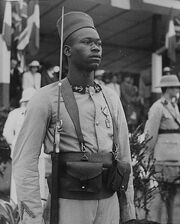
Solder of the "Zouaves Azaniennes" being decorated for serving in the liberation of France.
Following the fall of France in 1940 the Equatorian forces stationed in France itself retreated and fought for Free France. French governor of Equatoria Pierre Nouailhetas decided to swear allegiance to the new pro-Axis Vichy regime. He began a reign of terror, many of his enemies were either executed or put into labour camps. All non-white and Jewish people in the colonial government were removed. A local branch of the Milice (Pro-German militias) were established and Nouailhetas used them to hunt down his rivals and critics, declaring them to be "Gaullists, Communists and British spies". Most knew that the victims of this purge were being persecuted to their personal rivalries with Nouailhetas and many were actually on the right. The newly-vacant government positions were filled by members of French Fascist parties or those who were close to the Authoritarian Governor. Most people in governemnt used their positions as a way to embezzle funds from the government while giving their seal of approval on whatever legislation the Fascists wanted. Berlin and Vichy were both aware of this rampant corruption but due to the geographic isolation of the colony there was little they could do. It was said that the ideology of Vichy Equatoria was Opportunism, not Fascism.
The Free French Equatorians helped expel the Vichy forces from Gabon and later got the opportunity to remove the Vichy administration from their homeland. Following the victory at the Battle of Port Libre the French Azanian forces brought local Partisans into their regiments and went on to fight the Italians in the East African campaign and later North African campaign. The nearby Italian colony of Italian Azania was occupied by the French and annexed by French Azania after the war. In 1944 they served in Operation Dragoon and later in the Liberation of France and Belgium.
Pierre Nouailhetas was executed after the war for crimes against humanity and treason. After the war numerous reforms were passed in the colony, including: the establishment of elected territorial assemblies, various economic reforms, full citizenship for people in the colonies, the end of legal restrictions that applied to blacks but not to whites, the end of forced labour and the promise that black Africans could serve in the National Assembly.
By the 1960s the regional oil industry meant that France had little desire to decolonise. Pro-French sentiment had largely held, as evidenced by Equatorian troops fighting in Algeria in the French army at the time. As such there was little domestic push for independence among the Black, Arab and White groups in the country. On the contrary, the Algerian National Movement had conducted several bombings in Equatoria, leading to the Algerian independence movement being seen as terroristic. Even Equatorians of Algerian decent spoke out publicly against independence from France, perhaps this was to avoid violence from the pro-French majority. During this time French Azania deployed troops to fight in the First Indochina War (1946-1954), Algerian War (1954-1962), Cameroon War (1955-1964) and the Gabonese Coup d'état (1964).
It was becoming clear that the French colonial empire was coming to an end, especially after the Vietnamese victory at the battle of Điện Biên Phủ. In 1962, French President Charles de Gaulle announced that France would be withdrawing military personnel from Algeria, which led to a revolt known as the General's Putsch, as some still viewed Algeria as an integral part of France and refused to let Algeria, the symbol of the French Empire, fall to the separatists. In French Azania, some members of the Organisation armée secrète backed by mutineers within the French Foreign Legion attempted a coup. This lead to anarchy in the colony that the French struggled to control, as leftist rebels tried to take advantage of the attempted coup to revolt. In the end, the rebellion was crushed and the coup failed, with some Organisation armée secrète members fleeing to Spanish Azania. As part of Operation Angel (Opération Ange) France conducted airstrikes against OAS targets in Spanish Azania.
The year 1967 saw further instability in French Azania. As with many Muslim-majority areas, there were riots targeting Jews that broke out as a result of the Six Day War. Additionally, the French government found evidence of deep-rooted corruption in the colonial government, as well as a rapidly rising crime rate. This led to the declaration of martial law in French Azania, as military and police forces were sent from France itself to enforce laws and arrest officials from the local government and police force that were accused to corruption.
Still, Equatoria became independent on March 30, 1968 (Islamic New Year). This was the first country in Africa to gain independence from France since Algeria in 1962, it was also France's last colony on the continent to gain independence.
Equatoria was in a relatively stable position at independence, since it had a diverse economy based on profitable industries like oil. The local military was well equipped due to their participation in recent wars, and the transition from French command to independent leadership was smooth. Equatoria still wanted to assist France militarily in Africa, leading to Equatorian involvement in the Nigerian Civil War on the side of Biafra. Equatoria had also managed to avoid a war of independence, meaning infrastructure was still intact and the country was still on good terms with France, who remained independent Equatoria's largest trading partner.
The country still had several serious issues, including widespread corruption, income inequality (largely along ethnic lines) and a government made of French-Era elites with little interest in a transition to democracy.
The planned 1970 election was postponed and many felt that the 1975 election was rigged to favour parties led by the ruling class from 1968. Protests were suppressed by the military. Later that year a coalition of opposition parties (mostly representing natives and immigrants against the European and Omani Arab elites) attempted a revolution that nearly led the nation to civil war.
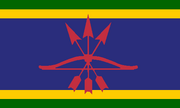
Kitara Nationalist flag
Kitara Nationalism started to form around this time, with some Kitara people believing that their historic homeland had changed demographically. Kitara Nationalists believed that Kitara people, as the largest ethnic group and the historical foundation of the country, should remove other ethnicities from political power to create a nation for Kitara people. Some members of this new movement wanted to secede to create an independent Kitara Republic, while others wanted to confirm Kitara people as the dominant ethnic group in Equatoria. The groups that wanted to achieve this were further radicalised by the fact that most people in government were either Arab or European, with natives and immigrants both largely excluded from power.
The government was concerned that Kitara Nationalists and the united opposition parties were both rapidly militarizing, and feared that the Kitaras could try to use the instability as a way to attack nearby Sheba (which has over a million Kitara people living in its borders) to try to achieve a Kitara irredentist state.
Government troops arrested Opposition leaders and raided their meetings. This action led many Opposition leaders to believe that the opportunity for peaceful resolution was over. A group of several armed men ambushed a Government Army convoy outside of Bandari in 1975, leading to the Equatorian Civil War.

French paratroopers during Equatorian Civil War
France announced its intention to conduct a military intervention in Equatoria to restore order. They targeted four rebel groups, Movement for Equatorian Democracy (Movement pour la Démocratie Équatorienne, MDE), the Kitara National Liberation Front (KNLF), the Progressive Islamic Liberation Party (Parti progressiste de libération islamique, PPLI) and the Equatorian communist Party. Other nations soon became involved, with South Africa, the United States, Israel and Zaire sending support to the Equatorian government, with the USSR, Sheba, Cuba, Angola, Nigeria, Libya and Algeria sending support to the rebels. After the rebels started to lose ground they transitioned to a guerilla force to resist Franco-Equatorian forces.
After two and a half years of fighting the crisis came to an end and the Equatorian government agreed to follow a plan for Democratisation, allowing both the MDE and KNLF to run as opposition parties, in exchange for a ceasefire. This plan was defined in the Dakar Accords, signed at the Senegalese capital. The Communists had already been beaten by that time, while the PPLI were facing intense internal division. At the same time a new Separatist faction arose in Juba Province (on a Azanian mainland) seeking independence on the grounds of the Central Government being neglectful of its non-insular territories, and the area was ethnically distinct from the island regions. Juban Separatists would continue to resist until 1989. France withdrew its ground forces in 1978. The Equatorian Communist Party was excluded from the Dakar Accords, leading to it beginning its own war against the Equatorian Government.
The global oil market was heavily disrupted by both the Iranian revolution and the Iran-Iraq war. Equatoria was not a member of OPEC due to the instability of their civil war, this meant that they had to navigate to 1979 energy crisis on their own. Due to damage to oil infrastructure caused by the war, Equatoria was unable to met their export commitments. This led to inflation and a recession. Their overall economic difficulty was heightened by their diplomatic isolation caused by their close relationship with South Africa.
The South Africans already had sanctions against them, including restrictions on trade and investment, and were hit hard by the 1979 energy crisis. They responded to the crisis by increasing domestic production and making reforms to be less reliant on oil, while still diversifying the sources of their imports. This led to Equatoria dramatically increasing their oil exports to South Africa. In exchange for this, the Equatorians managed to convince the South Africans to include Kitara people and Equatorian Swahilis as "Honorary Whites" under the Apartheid system. The greatest extent of the Equatorian government's Pro-South Africa stance was their official support for Rhodesia during the Rhodesian Bush war.
Due to this, several OPEC members (Gabon, Nigeria, Algeria) boycotted Equatorian admission into OPEC. Equatoria had already formed close relations with several of the Gulf State members, so they were admitted into OPEC in 1988. Equatoria also greatly strengthened their alliance with France during this period, as well as other Western nations, primarily the United States. Economic ties to growing economies, such as South Korea and China, were prioritised, while trade with nearby countries also increased. The most controversial aspect of Equatorian foreign policy during this period was the nation's close ties to Israel which had started during the Equatorian Civil War. The growth of the oil industry and related sectors led the Equatoria government beginning a foreign worker recruitment program called the Dhamana system. This was part of the "Dubai Plan", which was an effort by the Equatorians to model their economy on those of the Arab Gulf States. This time period (1980s to 2000s) saw the Equatorian economy grow immensely, while the government made an effort to strengthen the nation by resolving issues that led to the Civil War and issues that arose in the aftermath of the war, such as the high crime rate. Equatoria also began to join France in military operations in Sub Saharan Africa in order to both strengthen ties between the two countries and also to create an Equatorian sphere of influence in the region.
At the suggestion of General (and Presidential candidate) Nishan Ayache, President Ali Mimouni agreed to begin taking a more active role in international affairs. Equatoria joined the US-led Coalition against Iraq following its invasion of Kuwait, while that same year it agreed to deploy Peacekeepers to Namibia and Western Sahara. Equatoria began to provide support to the FLEC separatists in the Cabinda region, due to its oil wealth and the fact that France was already involved in the conflict. In another conflict involving France, Equatoria was a major supporter of the Chadians following a Libyan invasion. This conflict lead to the creation of Equatoria's first overseas military bases (in Sarh and Abéché in Chad) as well as the beginning of a longstanding rivalry between Libya and Equatoria, as the two oil-rich nations fought proxy wars across Africa in an attempt to create rival spheres of influence. The "African Cold War" (1991-2011) saw proxy wars occur in Chad, Sierra Leonne, Liberia, the Congo and the Central African Republic, among others. The Equatorian Intelligence Agency became a highly developed organisation at this time, due to its involvement in sabotage, coups, assassinations and destabilization efforts. Libya and Equatoria mutually supported insurgents in each other's countries, from Libyan support to the Juban Separatists to Equatorian support for the Toubou Front for the Salvation of Libya. The arms race between them gave both a massive arsenal of weaponry.
Equatoria is divided between the mainland region, which includes the regions of Juba and Sainte-Marie, and the insular parts of the country. On the mainland the country borders both Kenya and Sheba. Much of the mainland is covered in dense rainforest known locally as Bwindi, which means "Place of Darkness". The Sainte-Marie river goes through the southern part of the mainland and the area is the main agricultural area of teh whole country. The main islands are Harashat, Kaluma, Bandari, Tromelin and São Miguel, the later two are smaller and have fewer people while being located much farther to the south. Harashat and Kaluma are both covered with a mix of tropical rainforests and savannah while Bandari is semi-arid plateau with more vegetation around parts of the coast.
The capital and largest city is Port Libre, located on the island of Harashat. The cities of Kaluma and Bandari are each located on the islands of the same name, while Sainte-Marie and Juba City are each located on the mainland.
Equatoria is Azania's strongest economy in terms of GDP per capita. For centuries the area of modern day Equatoria has been one of the continent's most urbanised regions, and occasionally one of its most densely populated and industrialised. Port Libre is Africa's centre of education, finance, art and media, real estate, technology, transportation, fashion and commerce. Equatoria ranks high on the ease of doing business index.
For Further information, see: Political History of Equatoria
A total of 8 political parties have fielded candidates in Equatoria's Presidential Elections
The Kitara people in Equatoria are 4,689,996 (36.5%). There are 5,704,651 Kitara globally since 1,014,655 of them live in neighbouring countries, primarily Sheba. The main language spoken by this group is the Runyakitara language, which is part of the Bantu family. Since this group formed in the 500s, it has been under near constant foreign influence, especially in regards to cultural influence. Arab, Sheban, French and Portuguese influenced can all be seen, as the the Runyakitara language contains loanwords from Arabic, Persian, Portuguese and French, while their alphabet is written in either Arabic, Ajami or Latin scripts. The 1970s saw the rise of Kitara Nationalism, which was an important element in the Equatorian Civil war (1975-1977). Although Kitara nationalists are associated with violence, many moderates simply wanted to start a cultural revival, which called for foreign influence on their culture to be reduced, such as by creating a distinctly Kitara alphabet (although it never caught on).
The native people of Juba number at 2,480,622 people (19.31%). The Jubans are mostly Bantu with considerable Hadza admixture, with smaller amounts of Habesha and Middle Eastern heritage. They are divided into three distinct ethnic groups: Maraba, Kambiri and Wanjiku.
In most East African countries the term "Swahili" is a linguistic and cultural identity, but in Equatoria it means people with mixed Afro-Arab ancestry. In the 600s native Bantu people started to interact with explorers from the Arabian peninsula, resulting in intermarriage and cultural exchange. Most were commoners but some mixed race people became royalty, such as the Al Said Dynasty. Under the Omanis many slaves were brought from Central Africa to their colony in Equatoria, some intermarried with Arabs or Swahilis. Most Swahilis were slaves but some became slave owners as many Arab slave owners gave freedom to mixed-race children they had and left the shamba (Plantation) to them as inheritance. Swahili people don't see themselves as half Arab and half African but rather as fully Swahili. The 1,687,002 Swahilis in Equatoria are divided quite evenly between Islam and Catholicism.
There are 1,512,445 Arabs in Equatoria (11.7%). The Arabs in the country can be divided in several subgroups. Arabs have lived in Equatoria for 1400 years, as merchants and explorers. Later many Arabs moved to the area from Oman, Yemen, Kuwait and Bahrain when it was owned by the Omani empire. Also included in this migration were Mehri, Kumzari, Persian, Baloch, Jewish and Assyrian minorities from those nations, they have since assimilated into Arab society. There were also slaves from the Caucasus, such as Abkhazians, Circassians, Georgians and some local Turkic peoples, although these groups have also assimilated into Arab culture due to their small numbers. This second wave became elites of the nation and form the majority of the Arab population (979,000). In the French colonial period many were brought to work in the oil industry from other French colonies especially Algeria, Morocco and Tunisia, as well as Levantine Christians from the Ottoman Empire. There are 347,920 Maghrebis (49.29% Algerian, 42.6% Moroccan, 8.1% Tunisian) and 185,525 Syro-Lebanese. Other Arab groups include Adeni Jews who started to immigrate to French Azania from Yemen during the 1890s. Majority today are bilingual between French and Arabic while most are Sunni Muslims, although Christians, Ibadis, Shias and Jews exist as well.
An ethnic group known as the Sainte-Marie Creoles lives on the Azanian mainland territory of Equatoria. This group is the descendants of French colonists in the late 1600s who intermarried with native Juban ethnic groups, including the Marabas, Kambiris, Wanjikus, Hadzas, Swahilis and Arabs. In addition to native ethnicities, French settlers and later Creoles also intermarried with slaves that were imported from Zambezia. A distinct French-based creole language also developed as a result of this intermarriage. There are 979,988 Sainte-Marie Creoles in Equatoria today. In addition to assimilated natives, this category also included freed slaves (Affranchis). Although this group largely originated in and around Sainte-Marie, many of its members have migrated throughout Equatoria, with Port Libre having a large population of Creole people.
The fastest growing group in Equatoria are people from the African mainland who have immigrated to Equatoria. Currently, there are 666,784 people (5.19%) who are either immigrants from mainland African countries or people whose ancestors were. Most still speak French as their first language since they have no contact with the culture of the country their great grandparents moved from. Historically Congolese, Chadian and Senegalese were the majority of migrants. Congolese due to their proximity (and high emigration rate due to the Free State's atrocities). Chadians were numerous since their homeland was underdeveloped by French authorities, slave-trading and banditry were both still common and there was little to no economic prospects outside of cotton production or the French Army. Senegalese migrants were mostly fleeing climate change and poverty. In the 1980s, Equatoria created a policy known as Dhamana, based on the Kafala system of the Arab Gulf States, although it is far more humane than the system in the GCC. Workers arrived from the three aforementioned countries of Senegal, Chad and the Congo, as well as Cameroon, who are all valued for their ability to speak French. Many non-Francophone workers have arrived through the Dhamana program as well, including Ghanaians, Nigerians, Angolans and Zimbabweans. Refugees from civil wars in Mali, Côte d'Ivoire, Congo and Central African Republic form the rest of the population. Most Dhamana workers are in sectors such as energy, telecommunications, tourism, retail, construction and shipping, as well as domestics and doctors. After their work contract is over, most Dhamana workers are given Equatorian citizenship and are allowed to bring their family to Equatoria.
Around 3.5% of Equatoria's population is of European decent. This leads to 467,443 White Equatorians. The vast majority of them, 325,717 people (72.5%), are French. Others are Italian (15,911), Spanish (11,667), Greek (10,381), Armenian (8152), Portuguese (7724), Maltese (5850, formerly 13,000) and Afrikaner (924). As in Algeria, the descendants of European settlers are known as Pied-Noirs.
There are 120,262 Equatorians with Caribbean ancestry. Afro-Caribbean migrants started to arrive in Equatoria due to the oil boom, most came from French-speaking territories such as Guadeloupe or Martinique. Various aspects of Equatorian society, including music, dance, cuisine and religious practices trace their origins back to the Afro-Caribbean migrants of this time period. Today most Caribbean Equatorians only speak French, as the use of Antillean Creole ended after only a generation in French Azania.

A Tamil Hindu temple in Bandari
Migration of Indians to Equatoria started in the 700s when Indian merchants arrived alongside those of Arab and Persian origin. Indian Muslims (as well as people from modern day Pakistan) were granted preferential treatment in business under Omani rule, mostly Gujaratis, Kutchis and Sindhis. Following the French acquisition of the colony in 1885, indentured labourers began to arrive from French India, mostly Tamil, Telugu and Bengali speakers. Other Indian workers came from British India, mostly Bhojpuris. Britain banned Indian migration to French colonies due to poor treatment of them, within a few decades 1/4 of British Indian workers had died. These workers were referred to as "Girmityas". Today the 95,047 Indo-Equatorians (0.7%) are overrepresented in finance and the police force, showing that they have climbed the social ladder in the country.
Around 56,713 Equatorians have Balochi ancestry. Many Balochis migrated to Oman and found work as sailors and soldiers. Although officers in the army were Omani Arabs, most soldiers were Yemeni, Balochi, Pashtun or Persian mercenaries or Mamluks of Caucasian, Balochi or East African descent. They helped subdue rebellion in Omani colonies. The first Balochs were single men who intermarried with locals, while whole families soon followed from Iranian Balochistan. They settled in both urban and rural areas, working as farmers and merchants. Most Equatorian Balochs are Sunni, although some remain Shia, while most are fluent in Arabic, Swahili and Balochi. Some are mixed Afro-Balochs or Arab-Balochs. Pashtun settlers in Omani Equatoria assimilated into Balochi culture.
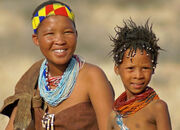
Mainland Hadza near Juba
The Hadza people, who have lived in the region for tens of thousands of years, only number 33,104 (0.3%). The Hadzas of Equatoria are divided into 3 subgroups, Southern Islander, Northern Islander and Mainlander. The Northern Hadza tribes were conquered by the Kitara Empire in the 500s and subsequently assimilated them into their own culture. The Northern Hadza only number around 100, but many Kitara people in the area have Hadza ancestry. The Southern Hadza live primarily on the island of São Miguel (the Southernmost island in Equatoria), which was never incorporated into the Kitara Empire. The Southerners were only contacted by outsiders in 1502, when the Portuguese landed on the island. The São Miguel Hadza experienced a high death rate due to foreign disease being introduced. On the mainland most Hadza had been conquered by Coastal Swahili states (such as the Sultanate of Juba) while others remained uncontacted by outsiders until French contact in the early 1900s.
There are 25,861 Equatorians with Vietnamese ancestry. Contract workers from Tonkin started to arrive in French Azania in 1890. They were referred to as "Chân Đăng" in Vietnamese. The first wave of Vietnamese immigrants were fleeing famine and poverty back in Vietnam and were told that Equatoria was a wealthy country that needed workers for the oil industry. This process of recruiting Vietnamese workers continued until 1940. Many were unable to return to Vietnam due to the Indochina wars. Vietnamese cuisine, especially Nem rán with nước mắm is popular in Equatoria.
The number of Equatorians with Persian ancestry is around 18,962. The first Persians were merchants who arrived in the 600s alongside Arab ones. Persian minorities (Ajam people) living in Kuwait and Bahrain settled in the Omani colony since their homeland was also under Omani rule. Persian mercenaries served in the Omani army alongside Afghans and Yemenis. According this group’s oral history, 7 Sunni Persians moved from the Shiraz region of Iran to the Swahili coast, where they absorbed local culture before moving on to settle on many islands in the Eritrean sea, the west coast on Azania and the Congo. Genetic testing has proved that the closest relatives of this ethnic group are Afro-Iranians. They are mostly Swahili-speaking Sunni Muslims, although there are Catholics.
Cabo Verdean immigrants were counted as Portuguese citizens when they first started moving in the 1920s. Many worked as artisans. Around 16,100 Equatorians have Cape Verdean ancestry. Most are Catholics that speak both French and Portuguese.

Chinatown, Port Libre, 1890
There are 9837 Sino-Equatorians. The first Chinese immigrants arrived in 1886. Hakka and Cantonese workers from the Liangguang region, as well as Hoa people (Han Chinese in Vietnam) from French Indochina, were initially recruited to work on local vanilla plantations. Many eventually went on to work as shopkeepers and fishermen. Early immigrants founded a Chinatown neighborhood in Port Libre, in which many Chinese and Vietnamese immigrants lived, although the neighborhood no longer exists due to Sino-Equatorians leaving the area.
Another group from Southeast Asia, along with the Vietnamese, are the 6983 Equatorians of Indonesian descent (Javanese specifically). In the Dutch East Indies the Javanese peasants were forced to grow cash crops for export instead of traditional subsistence agriculture. This led to poverty and food shortages among the Javanese who began to emigrate to French colonies such as New Caledonia, French Guiana and Equatoria. In French Azania they worked in agriculture, as well as oil workers and domestic servants. This was part of a plan to replace the Vietnamese who had gone on strike in 1896. They received citizenship after working for 8 years.
Sunni Islam is the largest religion in Equatoria, with 39.6% of the total population being Sunnis. The first Arab explorers who arrived in the 600s were Sunnis, they converted locals and the new Swahili people to their religion. Many Sunnis from Yemen moved to the area during the Omani period and finally migration of Sunnis from the Maghreb, Sahel and Balochistan contributed to the population. Islam is practiced by 62.4% of Equatorians.
The second largest religion is Roman Catholic Christianity, with 32.1% of Equatorians being Catholic. Catholicism only started in 1885, when French Catholic missionaries arrived. Since the French abolished slavery they were seen as liberators and many former slaves viewed France in a very positive way and were highly receptive towards missionaries. Many were Sunni or Ibadi Muslims before and found Christianity to be similar enough. European settlers were mostly from Catholic countries as well, while most immigrants were from colonies that had Catholic majorities, such as Cabo Verde and the Caribbean, or areas such as Indochina and French Africa, where Catholic missionaries were present for decades. There is also a large population of Lebanese Catholics.
Ibadi Islam is the dominant sect of Islam in Oman. Equatoria was an Omani colony for 189 years and as such Equatoria has one of the highest percentages of Ibadi Muslims of any country at 19.9%. Many Arabs in Equatoria are of Omani origin and have remained followers of Ibadism, and many converted their slaves to the Ibadi school. Oman tried to restrict efforts by Sunnis to convert native people but were largely unsuccessful.
Protestants are a newer religious group in the country, at around 6.5%. In the late 1800s there were Anglican, Calvinist and Baptist missionaries from the UK, US, South Africa, Germany and Switzerland, although they did not have as much success as Catholic ones. Protestant missionaries were especially successful in the Juba region on the Azanian mainland, primarily among the region’s tribal communities who had no previous contact with either Islam or Christianity. Protestant missionaries continue to arrive in Equatoria today, especially Evangelicals from the United States, and have had some success in recent years. Some of the first foreign Protestants in French Azania were Calvinist Afrikaners who immigrated in 1908. There are around 220,149 Protestant immigrants from African countries, including Cameroon, Zimbabwe, Ghana, Nigeria and the Central African Republic.
Hindus are 0.7% of Equatoria's population. All Hindus in the country are Indo-Equatorians.
There are around 67,772 Orthodox Christians in Equatoria (0.5%). The vast majority of them are of Lebanese decent, with smaller numbers of Greeks, Armenians and Georgians. The Sheban Orthodox Church was once prominent in the country until they were persecuted and expelled by the Omanis.
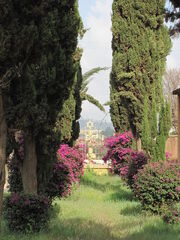
The Jewish cemetery in Port Libre
Around 0.4% of Equatorians are Jewish (45,388). Most are either Sephardi or Mizrahi Jews who arrived from Morocco or nearby Yemen in the late 1800s. The history of Jews in Equatoria goes back to the Portuguese colonial period (1502-1692), when small numbers of Sephardic Jewish Conversos arrived as merchants and artisans. They faced intense persecution from the Portuguese Inquisition until they were expelled in 1696 by the Omanis following their capture of the territory. Under the French, migration from Morocco and especially nearby Yemen saw the arrival of many Jews, many of whom found work as dock workers, craftsmen and goldsmiths. During the Six-Day War, the Jewish population of French Azania was accused of supporting Israel and were the victims of violence, amounting to riots targeting Jews in French Azania's major cities. Around two thirds of the 59,406 Equatorian Jews emigrated to Israel as a response to the violence. Despite this, Port Libre still has two Synagogues, a Jewish school and a cemetery. Equatorian Jews in Israel have mostly assimilated into the general culture of Mizrahi Israelis without knowing where they came from.
Buddhism is practiced by a portion of Vietnamese Equatorians. Christianity is overrepresented among the Vietnamese diaspora when compared to Vietnam itself, and this trend is true for Vietnamese Equatorians. The Mahayana school is most common among Chinese and Vietnamese Equatorians. Only 0.2% of the country's population is Buddhist.
Various ethnic groups in the region have traditional animistic religions, most of which have their roots in the beliefs of the Hadza. The native Hadza have mostly converted to Christianity, and Islam to a lesser extent, but their original faith is still practiced by some in the community as well as by some Kitara/Juban people. The local religion believes that everything has a spirit that can live on after death, leading to the concept of ancestor worship. Some spiritual significance is given to celestial bodies as well. There is a supreme God, Warongwe, but he is an entity that is very disengaged from human life, the logic being that anyone with the power to create the universe would have no understanding of human life just as we could never understand the struggles of an insect. Spirits can be contacted through ritualistic dances that usually accompany major life events and natural blessings such as the harvest. These practices were regarded as witchcraft and sorcery by both Muslim and Christian observers. Various groups that settled in modern-day Equatoria after the Hadza adopted their religion but modified it in some way, the native faith of the Kitara includes the same basic beliefs while replacing Warongwe with Nyambe, creating a more expansive pantheon and adding a complex mythology. Only around 11,000 people in the country still follow these beliefs today.
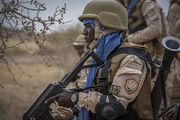
Equatorian soldier in Sahel, c. 2020
For Further information, see: Equipment of the Equatorian Armed Forces
Despite its small size and population, Equatoria possesses a large, highly trained military armed with imported weapons from France, the United States, Germany, the UK, Spain and other allies. Equatoria currently has personnel involved in operations in the Congo, Central African Republic and the Sahel, as well as domestically against the separatists in Juba. It has become a notable ally of Western countries in the war on terror in Sub-Saharan Africa. Equatoria is also a major contributor to UN peacekeeping missions, primarily those in Africa. Equatoria's equipment is mostly manufactured in Western countries, especially France and the United States, it is able to afford modern equipment due large reserves of oil and large defense budget. Equatoria has purchased large quantities of modern military equipment from their Western allies, including anti-materiel weapons, small arms, helicopters, grenade launchers, howitzer artillery, infantry fighting vehicles, rocket artillery, APCs, tanks, jets and UAVs. Equatoria provides training, and often weapons, to various national governments and rebel groups across the continent, which has given Equatoria a large network of allied governments and non-state actors across Africa, in a similar manner to how many of the Arab Gulf States treat their neighbors. This Interventionist attitude has led to Equatoria having strained relations with many nearby nations, especially since Equatoria often participates in French military interventions in Africa, which has led to them being seen as a French puppet and a collaborator with Neocolonialism, although the Equatorian government rejects both of these accusations when they are made by other African nations.
The Equatorian Armed Forces consists of the Army, Navy (including Marines), Air Force and Gendarmerie. Since the beginning of the War on Terror, Equatoria has invested into Special Forces Units. The country's various Police Forces are led by municipal governments. The Ministry of the Interior has authority over both the National Guard and Gendarmerie. The National Guard consists of military reserve troops who preform in internal security, while the Gendarmerie is a branch of the armed forces tasked with domestic law enforcement and serving as military police. The country's military structure is the direct successor of the colonial defense forces of French Azania, including the Tirailleurs, Spahis, Chasseurs, Zouaves and Troupes de marine.
Currently the Equatorian Armed forces are engaged in combat in the Congo, Central African Republic and Nigeria, while also recently fighting in Juba and the Sahel. They contributed forces to the Gulf War against Iraq in 1991. Equatorian peacekeepers have served in numerous UN peacekeeping missions, including UNTAG (Namibia, 1989-1990), MINURSO (Western Sahara, 1991-), Several UN missions in Haiti (1993-2019), UNIFIL (Lebanon, 1978-) and UNSMIS (Syria, 2023-).
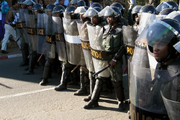
Port Libre riot police during the 2018 election protests
Equatoria's police force is, like the military, a large and well-funded organisation. It also possesses equipment that has been imported from Western countries. Equatoria's Police service has the goal of preventing crime and protecting its citizens. Many have noticed that Equatoria has a relatively low crime rate and the best-funded division within the Police force is Riot Control. These facts, combinded with Equatoria being considered a Hybrid Regime and a history of police brutality, have raised concerns that the Police are little more than tools used by the Equatorian Government to suppress dissent. Recent uses of the Gendarmerie have been 2014 Anti-Indian riots, 2018 election protests, 2022 anti-immigrant protests and the 2023 Witch-hunts. The Gendarmerie have also been used in the ongoing crackdown on organised crime in Equatoria.

